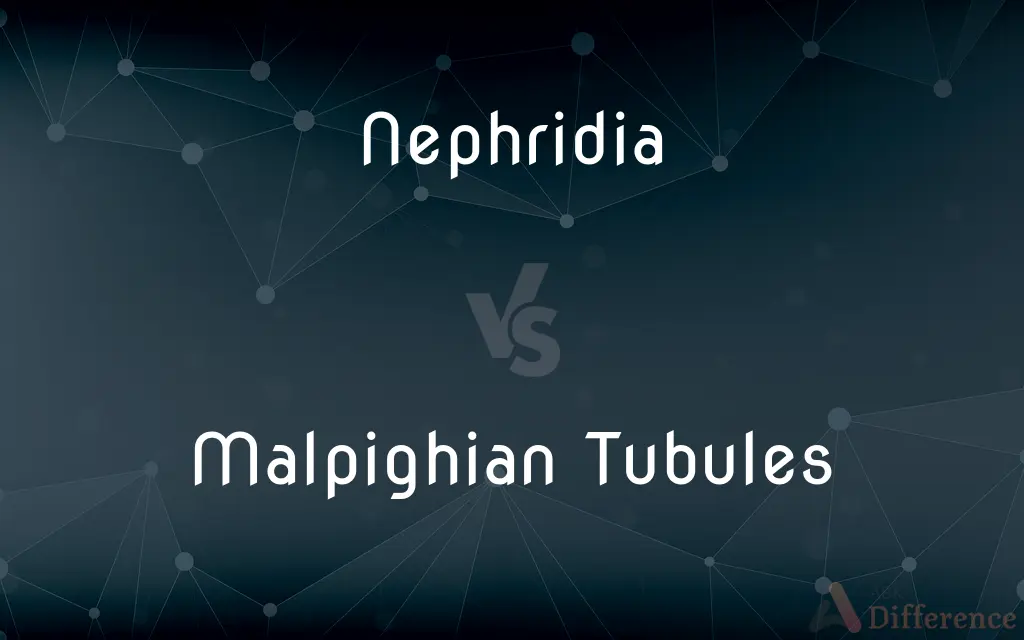Nephridia vs. Malpighian Tubules — What's the Difference?
By Tayyaba Rehman & Fiza Rafique — Published on February 1, 2024
Nephridia are excretory organs in annelids filtering waste from blood, while Malpighian tubules are excretory structures in arthropods, removing waste from hemolymph.

Difference Between Nephridia and Malpighian Tubules
Table of Contents
ADVERTISEMENT
Key Differences
Nephridia, serving as the primary excretory organ in many annelids, function by filtering metabolic wastes directly from the blood. Conversely, Malpighian tubules, predominantly found in arthropods like insects and spiders, extract wastes from the hemolymph, a fluid analogous to blood, facilitating osmoregulation and waste elimination without a direct blood filtration process.
The structure of nephridia typically includes a ciliated funnel opening into the coelom, through which waste enters and is processed before being expelled. Malpighian tubules, in contrast, are blind-ended tubes that float in the hemolymph, absorbing wastes and converting them into solid uric acid to be excreted.
Nephridia play a crucial role in maintaining internal osmotic balance by regulating the composition of body fluids. Malpighian tubules, on the other hand, contribute significantly to internal homeostasis by actively segregating and eliminating nitrogenous wastes while conserving essential ions and water.
While nephridia are evolutionary adaptations seen in simpler organisms like earthworms, providing a basic mechanism for waste removal and osmoregulation, Malpighian tubules represent a more evolved system, specifically tailored to the life cycles and environmental interactions of arthropods.
In the context of development and complexity, nephridia showcase a fundamental approach to excretion and osmoregulation, reflecting an evolutionary stage of organ development. Malpighian tubules, indicative of a more specialized and advanced evolutionary adaptation, cater to the specific needs of arthropods, facilitating intricate mechanisms for waste disposal and osmoregulation.
ADVERTISEMENT
Comparison Chart
Primary Users
Annelids (e.g., earthworms)
Arthropods (e.g., insects, spiders)
Location in Body
Coelom
Floating in hemolymph
Waste Filtration Method
Directly from blood
From hemolymph, not directly blood
Waste Product Form
Liquid form
Solid uric acid
Role in Osmoregulation
Regulate composition of body fluids
Segregate and eliminate wastes, conserve ions and water
Compare with Definitions
Nephridia
A series of segmented, tubular organs in some invertebrates, functioning in waste excretion.
Each segment of the worm contains nephridia for processing metabolic waste.
Malpighian Tubules
Structures in the insect digestive system, contributing to uric acid formation and excretion.
Malpighian tubules convert metabolic waste into uric acid for excretion in beetles.
Nephridia
Tubular excretory structures in annelids involved in osmoregulation and waste removal.
The earthworm's nephridia filter out waste materials efficiently from its body.
Malpighian Tubules
Blind-ended tubes in insects and arachnids, facilitating waste elimination and salt balance.
The spider relies on its Malpighian tubules to maintain salt and water balance.
Nephridia
Ciliated organs in annelids, facilitating the removal of waste from the body cavity.
The cilia in nephridia propel waste materials towards the body's exterior.
Malpighian Tubules
Key elements in arthropod osmoregulation, ensuring internal homeostasis.
Malpighian tubules play a vital role in maintaining the internal environment of the cricket.
Nephridia
Essential components of the excretory system in lower invertebrates, resembling renal organs.
Nephridia perform a function similar to human kidneys, albeit in a more primitive form.
Malpighian Tubules
Excretory and osmoregulatory system components in arthropods, aiding in waste removal.
The insect's Malpighian tubules efficiently remove nitrogenous waste from its body.
Nephridia
Primitive kidneys in certain worms, responsible for maintaining internal fluid balance.
The nephridia in flatworms act as primitive kidneys, regulating internal fluids.
Malpighian Tubules
Integral parts of the arthropod excretory system, minimizing water loss while excreting wastes.
The desert-dwelling scorpion's Malpighian tubules are crucial for minimizing water loss.
Nephridia
A tubular excretory organ in many invertebrates, such as mollusks and earthworms.
Nephridia
The excretory organ of a vertebrate embryo from which the kidney develops.
Nephridia
Plural of nephridium
Common Curiosities
Where are nephridia found?
Nephridia are found in each segment of annelids like earthworms.
What are nephridia?
Nephridia are excretory organs in annelids, similar to kidneys in higher organisms.
Do all insects have Malpighian tubules?
Most insects have Malpighian tubules, but there may be variations in structure and number.
What is the waste product excreted by Malpighian tubules?
Malpighian tubules excrete waste primarily in the form of uric acid.
Are nephridia present in all segments of annelids?
Yes, most annelids have a pair of nephridia in each body segment.
What is the main function of nephridia?
The main function of nephridia is to remove metabolic wastes and maintain fluid balance.
What are Malpighian tubules?
Malpighian tubules are part of the excretory and osmoregulatory system in arthropods.
Are Malpighian tubules and kidneys functionally similar?
They are functionally similar in that they both remove waste but are structurally and operationally different.
How do Malpighian tubules work?
Malpighian tubules extract waste from the hemolymph, converting it into uric acid for excretion.
Do nephridia and Malpighian tubules serve the same purpose?
Both serve excretory functions but in different organisms and through different mechanisms.
Can nephridia be found in humans?
No, nephridia are not found in humans; they are specific to annelids.
How do nephridia contribute to osmoregulation?
Nephridia regulate the composition of body fluids, contributing to osmoregulation.
Can the functioning of nephridia and Malpighian tubules be compared to human excretory systems?
Functionally they can be compared as waste removal systems, but structurally and operationally, they are quite different.
Do Malpighian tubules directly filter blood?
No, they filter hemolymph, which is analogous to blood in arthropods.
How do Malpighian tubules conserve water?
They reabsorb essential ions and water, minimizing water loss while excreting wastes.
Share Your Discovery

Previous Comparison
Delete vs. Shift Delete
Next Comparison
Seaman vs. Deck CadetAuthor Spotlight
Written by
Tayyaba RehmanTayyaba Rehman is a distinguished writer, currently serving as a primary contributor to askdifference.com. As a researcher in semantics and etymology, Tayyaba's passion for the complexity of languages and their distinctions has found a perfect home on the platform. Tayyaba delves into the intricacies of language, distinguishing between commonly confused words and phrases, thereby providing clarity for readers worldwide.
Co-written by
Fiza RafiqueFiza Rafique is a skilled content writer at AskDifference.com, where she meticulously refines and enhances written pieces. Drawing from her vast editorial expertise, Fiza ensures clarity, accuracy, and precision in every article. Passionate about language, she continually seeks to elevate the quality of content for readers worldwide.
















































